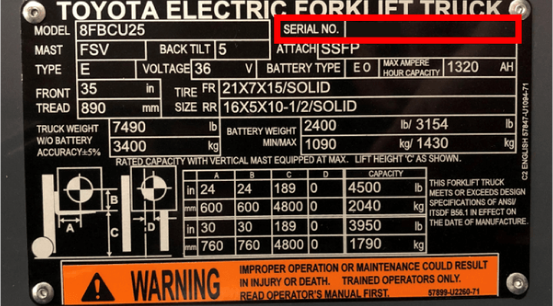How to Find Your Equipment Model Number.
Finding the right parts for your equipment is easy when you have your model and serial number which can be found on the data plate. Luckily, a forklift data plate is installed on every truck on the market to help you understand what your forklift can do and provide vital information.
Model Number: The model number of your toyota forklift is extremely important for relaying information to your dealers about repair or technical assistance and for looking up replacements part!
Serial Number: The serial number on your lift is the most important number.The model serial number combination will allow us to provide you with the parts that will fit your particular piece of equipment.

How to Find Your Equipment Serial Number
Finding the right parts for your equipment is easy when you have your model and serial number which can be found on the data plate. Luckily, a forklift data plate is installed on every truck on the market to help you understand what your forklift can do and provide vital information.
Model Number: The model number of your toyota forklift is extremely important for relaying information to your dealers about repair or technical assistance and for looking up replacements part!
Serial Number: The serial number on your lift is the most important number.The model serial number combination will allow us to provide you with the parts that will fit your particular piece of equipment.

Need some help? For further assistance or more information, contact your local Toyota Dealer.

Please click below to sign in to your MyToyota account
Don't have an account?
Understanding Forklift Inspection Frequency

Forklift inspection is a task that helps to ensure material handling equipment is up to par with operation standards at all times. But how often should operators inspect their forklift? Here’s a handy guide on the frequency of forklift inspection:
OSHA Forklift Inspection Requirements
OSHA’s Powered Industrial Truck Standard 1910.178(q)(7)
This standard is the one that controls all OSHA compliance on forklifts. To meet the standard, operators must inspect trucks:
- Daily (at the beginning of each day’s use)
- At the beginning of each shift in a continuous use facility
This standard compels operators to ensure their equipment is in good working condition. Failure to operate at this frequency can result in fines from OSHA. Any operator who finds a problem with a forklift must tag it out.
Why This Forklift Inspection Frequency?
The frequency of inspection helps to ensure the safe and efficient operation of your forklifts. By comparison, some of us are guilty of bad practices when driving our cars. We see something that will be a problem, and say to ourselves “that will need fixing… eventually.” But there’s going to be a moment in time when that problem will manifest itself in a very real and dangerous way. And then we’re in trouble.
Because forklifts are inspected daily or at the beginning of each shift, operators are able to catch potential problems early. And instead of having a major problem at the exact moment when a part or component breaks, we can perform maintenance that might prevent dangerous situations from ever happening.
The frequency of forklift inspection helps to combat that procrastination when operating a forklift. Because forklifts are inspected daily or at the beginning of each shift, operators are able to catch potential problems early. And instead of having a major problem at the exact moment when a part or component breaks, we can perform maintenance that might prevent dangerous situations from ever happening. Also, by requiring the operators to check their forklift at the beginning of a shift, businesses aren’t relying on someone who is exhausted at the end of a shift to perform checklist duties.